Envision Math Grade 8 Volume 1 Chapter 1 Real Number Exercise 1.4 Solutions
Page 25 Exercise 1 Answer
Given that, Matt and his dad are building a treehouse. They buy enough flooring material to cover an area of 36 square feet. We need to find all possible dimensions of the floor.
The given area is 36 square feet.
The factors of 36 will be,
36 = 3 × 3 × 2 × 2
36 = 9 × 4
36 = 18 × 2
36 = 3 × 12
36 = 6 × 6
Therefore, the possible dimensions are 9×4,6×6,3×12,18×2
The possible dimensions of the floor will be 9×4,6×6,3×12,18×2
Page 25 Exercise 2 Answer
We need to explain whether the different floor dimensions result in the same area.
The different floor dimensions obtained in the previous part is
9×4,6×6,3×12,18×2
All the floor dimensions result in the same area.
This is because the area of the square is A = s2
Here, the length of all the sides of the square is the same.
The area of the rectangle is A = l × b
Therefore, all the dimensions result in the same area.
Yes, the different floor dimensions result in the same area.
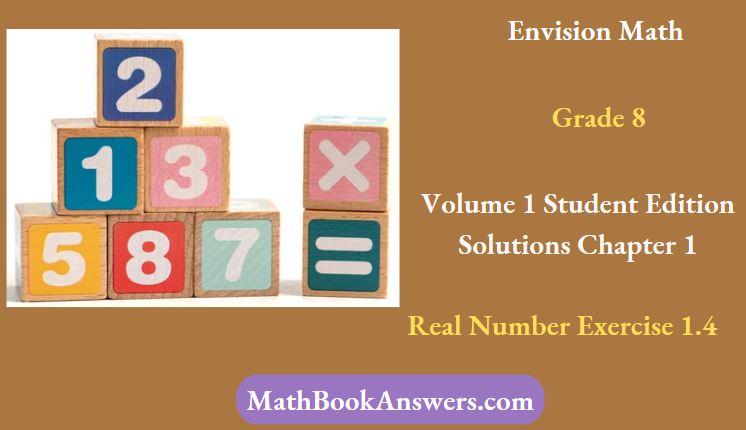
Page 26 Question 1 Answer
We need to explain how we could evaluate cube roots and square roots.
For finding the cube roots, find the number which when multiplied three times by itself gives the original number.
For example, if the number is 27
Then the cube root of this number is given by,
= 2
Thus, the cube root of the number 27 is 3.
For finding the square roots, find the number which when multiplied two times by itself gives the original number.
For example, if the number is 4.
Then the square root of this number is given by,
= 2
Thus, the square root of the number 4 is 2.
Cube roots can be evaluated by finding the number which when multiplied three times by itself gives the original number.
Square roots can be evaluated by finding the number which when multiplied two times by itself gives the original number.
Envision Math Grade 8 Volume 1 Chapter 1 Exercise 1.4 Real Number Solutions
Envision Math Grade 8 Volume 1 Chapter 1 Real Number Exercise 1.4 Solutions Page 26 Exercise 1 Answer
We need to explain what we know about the length, width, and height of the birdhouse.
The birdhouse is cube-shaped.
Its area is given to be 216 cubic-inch.
We know that the volume of the cube will be,
V = s3
V=s×s×s
In a cube-shaped figure, all the lengths of the edges are equal.
This means that the length, width, and height of the birdhouse will be the same.
The length, width, and height of the birdhouse will be the same since the birdhouse is cube-shaped.
Page 26 Exercise 1 Answer
Given that, a cube-shaped art sculpture has a volume of 64 cubic feet. We need to find the length of each edge of the cube.
The volume of the cube is 64 cubic feet.
The volume formula will be,
V = a3
where a is the length of each edge of the cube.
Thus, substituting the given in the formula, we get,
64 = a3
a = 4
The length of each edge of the cube is 4 feet.
Page 27 Exercise 2 Answer
We need to find the value of \(\sqrt[3]{27}\)
The given expression is \(\sqrt[3]{27}\)
Finding its cube root, we get,
\(\sqrt[3]{27}=\sqrt[3]{3 \times 3 \times 3}\)= \(\sqrt[3]{3^3}\)
= 3
The value of \(\sqrt[3]{27}\) = 3
We need to find the value of √25
The given expression is √25
Finding its square root, we get,
\(\sqrt{25}=\sqrt{5 \times 5}\) \(\sqrt{25}=\sqrt{5^2}\)= 5
The value of √25 = 5
We need to find the value of √81
The given expression is √81
Finding its square root, we get,
\(\sqrt{81}=\sqrt{9 \times 9}\) \(\sqrt{81}=\sqrt{9^2}\)= 9
The value of √81 = 9
We need to find the value of \(\sqrt[3]{1}\)
The given expression is \(\sqrt[3]{1}\)
Finding its cube root, we get,
\(\sqrt[3]{1}=\sqrt[3]{1 \times 1 \times 1}\)= \(\sqrt[3]{1^3}\)
= 1
The value of \(\sqrt[3]{1}\) = 1
Envision Math Grade 8 Exercise 1.4 Real Numbers Answers
Envision Math Grade 8 Volume 1 Chapter 1 Real Number Exercise 1.4 Solutions Page 27 Exercise 3 Answer
Given that, Emily wants to buy a tablecloth to cover a square card table. She knows the tabletop has an area of 9 square feet. We need to find the minimum dimensions of the tablecloth Emily needs.
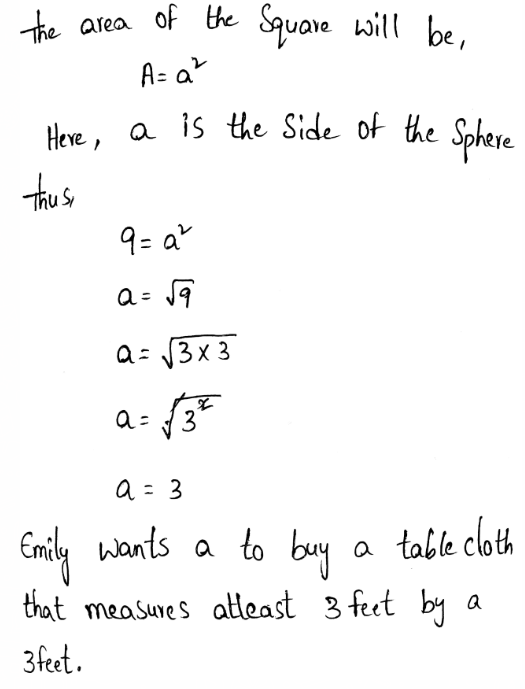
Emily wants to buy a tablecloth that measures at least 3 feet by 3 feet.
Page 26 Exercise 1 Answer
We need to find the cube root of 64
The given value is 64
Finding its cube root, we get,
\(\sqrt[3]{64}=\sqrt[3]{4 \times 4 \times 4}\)=\(\sqrt[3]{4^3}\)
The cube root of 64 is 4.
Envision Math Grade 8 Real Number Practice Problems Exercise 1.4
Page 28 Exercise 1 Answer
We need to explain how we could evaluate cube roots and square roots.
For finding the cube roots, find the number which when multiplied three times by itself gives the original number.
For example, if the number is 27
Then the cube root of this number is given by,
\(\sqrt[3]{27}=\sqrt[3]{3 \times 3 \times 3}\)= \(\sqrt[3]{3^3}\)
= 3
Thus, the cube root of the number 27 ia 3
For finding the square roots, find the number which when multiplied two times by itself gives the original number.
For example, if the number is 4
Then the square root of this number is given by,
\(\sqrt{4}=\sqrt{2 \times 2}\)= \(\sqrt{2^2}\)
Thus, the square root of the number 4 is 2.
Cube roots can be evaluated by finding the number which when multiplied three times by itself gives the original number.
Square roots can be evaluated by finding the number which when multiplied two times by itself gives the original number.
Envision Math Grade 8 Volume 1 Chapter 1 Real Number Exercise 1.4 Solutions Page 26 Exercise 1 Answer
We need to find the cube root of 64
The given value is 64
Finding its cube root, we get,
\(\sqrt[3]{64}=\sqrt[3]{4 \times 4 \times 4}\)= \(\sqrt[3]{4^3}\)
= 4
The cube root of 64 is 4.
Page 28 Exercise 1 Answer
We need to explain how we could evaluate cube roots and square roots.
For finding the cube roots, find the number which when multiplied three times by itself gives the original number.
For example, if the number is 27
Then the cube root of this number is given by,
\(\sqrt[3]{27}=\sqrt[3]{3 \times 3 \times 3}\)= \(\sqrt[3]{3^3}\)
= 3
Thus, the cube root of the number 27 is 3
For finding the square roots, find the number which when multiplied two times by itself gives the original number.
For example, if the number is 4
Then the square root of this number is given by,
\(\sqrt{4}=\sqrt{2 \times 2}\)= \(\sqrt{2^2}\)
Thus, the square root of the number 4 is 2.
Cube roots can be evaluated by finding the number which when multiplied three times by itself gives the original number.
Square roots can be evaluated by finding the number which when multiplied two times by itself gives the original number.
Page 28 Exercise 3 Answer
Given that, a cube-shaped box has a volume of 27 cubic inches. Bethany says each side of the cube measures 9 inches because 9×3=27
We need to determine whether Bethany is correct.
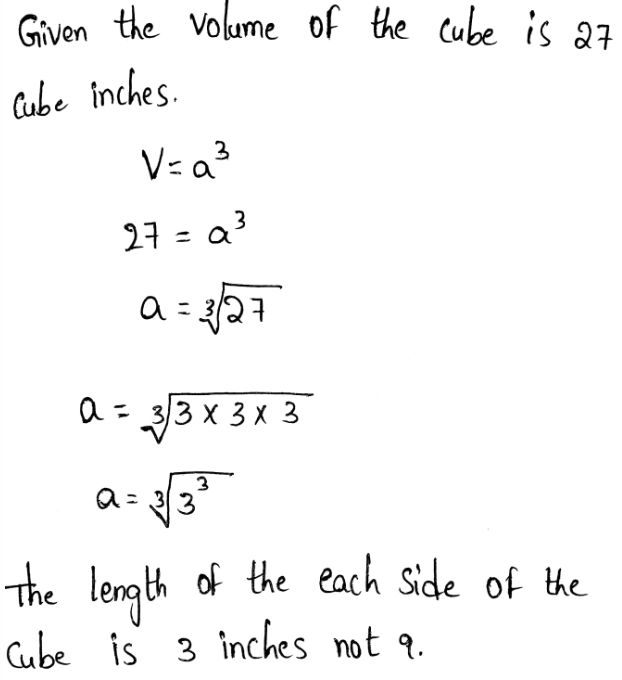
Bethany’s statement is wrong.
Envision Math Exercise 1.4 Real Numbers Detailed Answers
Envision Math Grade 8 Volume 1 Chapter 1 Real Number Exercise 1.4 Solutions Page 28 Exercise 4 Answer
Given that, a cube has a volume of 8 cubic inches. We need to find the length of each edge of the cube.
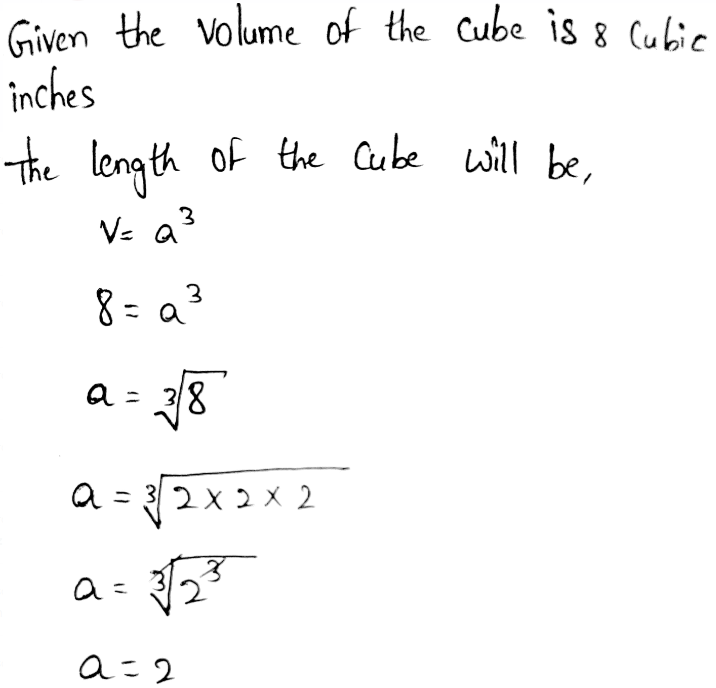
The length of each edge of the cube is 2 inches.
Page 28 Exercise 5 Answer
Given below is a model of the infield of a baseball stadium. We need to determine the length of each side of the infield.
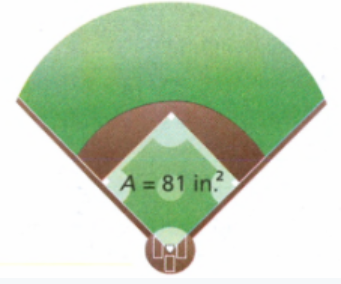
The area of the infield (the square) is given by 81
square inches.
The length of its side will be,
A = a2
81 = a2
\(a=\sqrt{81}\) \(a=\sqrt{9 \times 9}\) \(a=\sqrt{9^2}\)a = 9
The length of each side of the infield is 9 inches.
Page 28 Exercise 6 Answer
Given that, Julio cubes a number and then takes the cube root of the result. He ends up with 20. Find the number Julio started with.
If Julio cubes a particular number and then takes the cube root of the obtained result, he will end up with the same number.
For example, the number be 3
Taking the cube of it,
3 × 3 × 3 = 27
Taking the cube root of the result, we get,
\(\sqrt[3]{27}=\sqrt[3]{3 \times 3 \times 3}\)
= \(\sqrt[3]{3^3}\)
= 3
Thus, we obtained the same number at the end.
Therefore, the number julio started with will be 20.
The number Julio started with will be 20.
Real Number Solutions Grade 8 Exercise 1.4 Envision Math
Page 29 Exercise 7 Answer
We need to relate the volume of the cube to the length of each edge. The volume is given as V = 8cm3
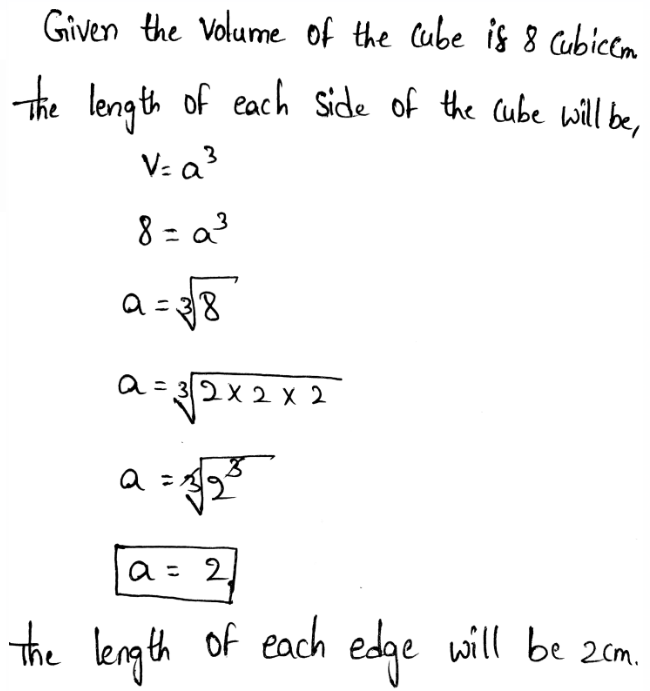
The length of each edge will be 2cm.
How To Solve Real Numbers Exercise 1.4 In Envision Math Grade 8
Envision Math Grade 8 Volume 1 Chapter 1 Real Number Exercise 1.4 Solutions Page 29 Exercise 8 Answer
We need to relate the area of the square to the length of each edge. The area is given as A=16cm2
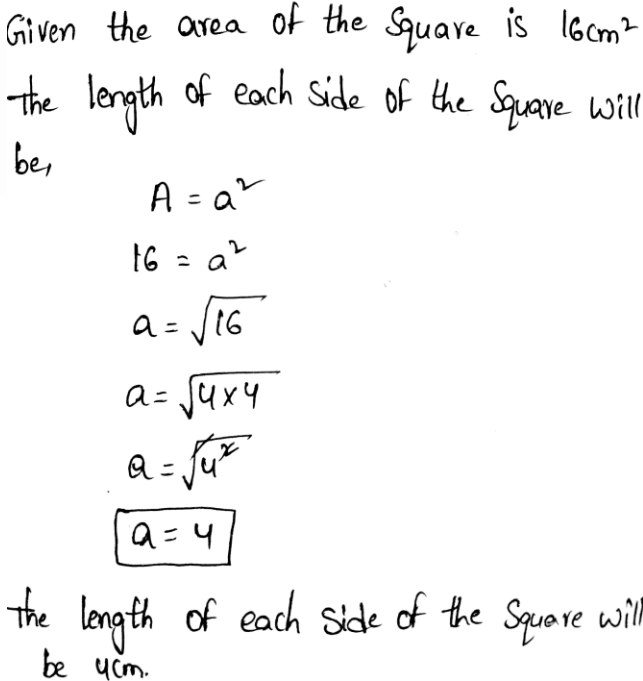
The length of each side of the square will be 4cm.
Page 29 Exercise 10 Answer
Given that the volume of a cube is 512 cubic inches. We need to find the length of each side of the cube.
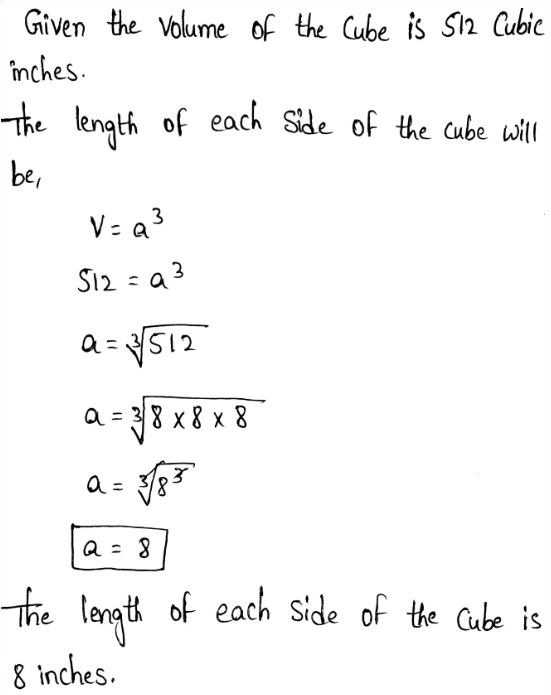
The length of each side of the cube is 8 inches.
Page 29 Exercise 11 Answer
Given that, A square technology chip has an area of 25 square centimeters. We need to find the length of each side of the chip.
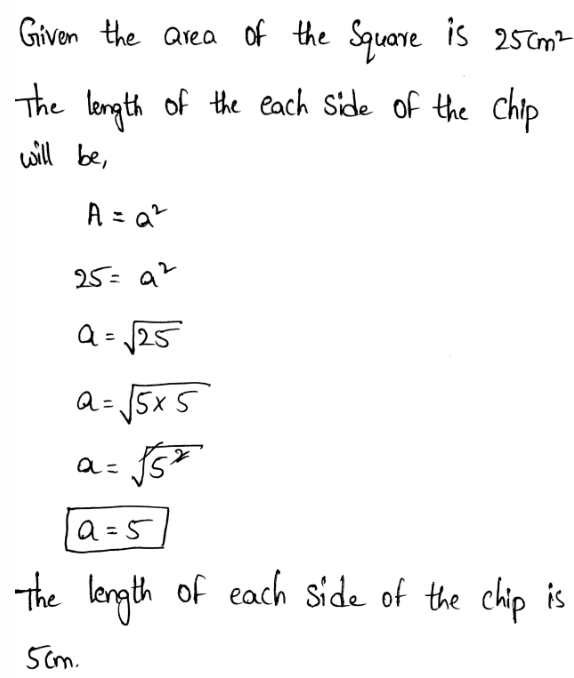
The length of each side of the chip is 5 cm.
Envision Math Grade 8 Chapter 1 Exercise 1.4 Solutions
Envision Math Grade 8 Volume 1 Chapter 1 Real Number Exercise 1.4 Solutions Page 29 Exercise 12 Answer
We need to classify the number 200 as a perfect square, a perfect cube, both, or neither and also explain.
Finding its cube root,
\(\sqrt[3]{200}=5.8480\)It is not a perfect cube.
Finding its square root, we get,
\(\sqrt{200}=14.1421\)
It is not a perfect square either.
The number 200 is neither a perfect square nor a perfect cube.
Page 29 Exercise 13 Answer
Given, A company is making building blocks. We need to determine the length of each side of the block.
The volume is given as V = 1ft3
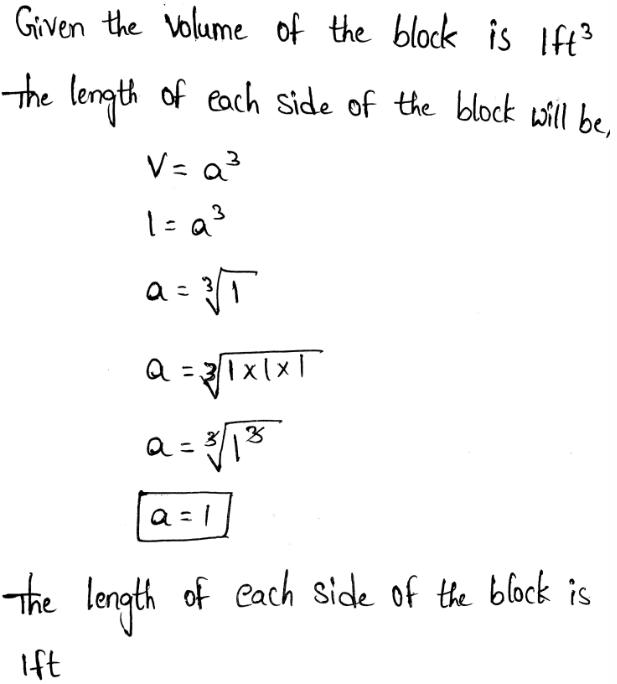
The length of each side of the block is 1ft
Page 30 Exercise 16 Answer
Given that, Talia is packing a moving box. She has a square-framed poster with an area of 9 square feet. The cube-shaped box has a volume of 30 cubic feet. We need to find whether the poster lie flat in the box or not.
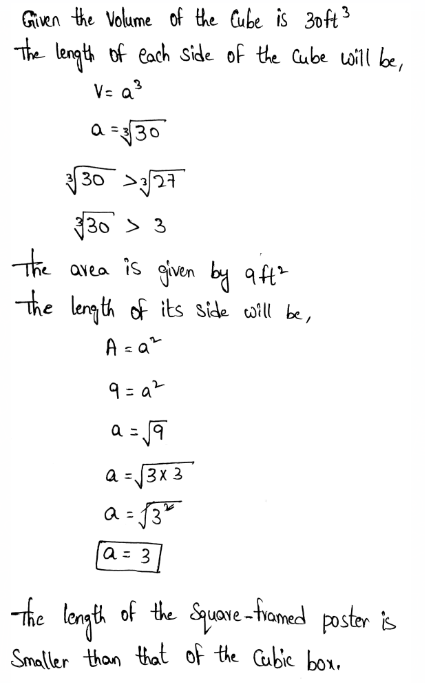
The length of the square-framed poster is smaller than that of the cubic box.
The poster lies flat in the box.
Envision Math 8th Grade Exercise 1.4 Step-By-Step Real Number Solutions
Envision Math Grade 8 Volume 1 Chapter 1 Real Number Exercise 1.4 Solutions Page 30 Exercise 17 Answer
We need to find which statements are true.
The statements are
49 is a perfect square.
9 is a perfect cube.
27 is a perfect cube.
14 is neither a perfect square nor a perfect cube.
1000 is both a perfect square and a perfect cube.
\(\sqrt{49}=\sqrt{7 \times 7}\)
= 7
Hence, 49 is a perfect square.
\(\sqrt[3]{9}=2.080\)
Hence, 9 is not a perfect cube.
\(\sqrt[3]{27}=\sqrt[3]{3 \times 3 \times 3}\)
= 3
Hence, 27 is a perfect cube.
\(\sqrt[3]{14}=2.410\) \(\sqrt{14}=3.7416\)Hence, it is not a perfect square nor a perfect cube.
\(\sqrt[3]{1000}=\sqrt[3]{10 \times 10 \times 10}\)
= 10
\(\sqrt{1000}=31.62\)
The true statements are,
49 is a perfect square.
27 is a perfect cube.
14 is neither a perfect square nor a perfect cube.
